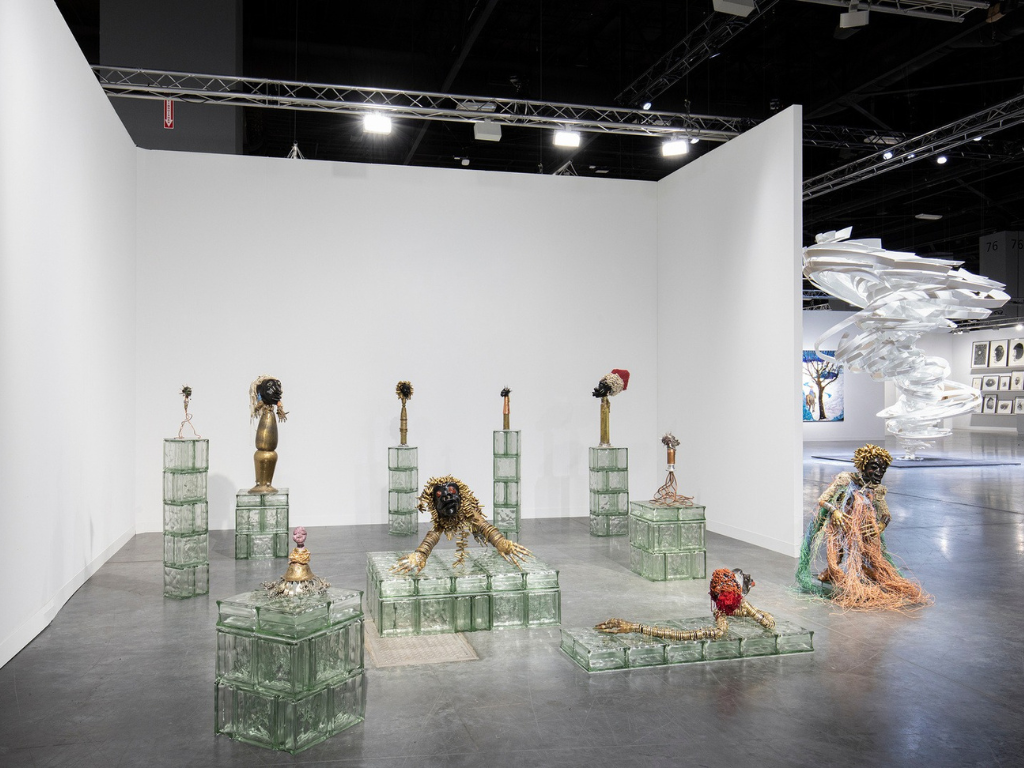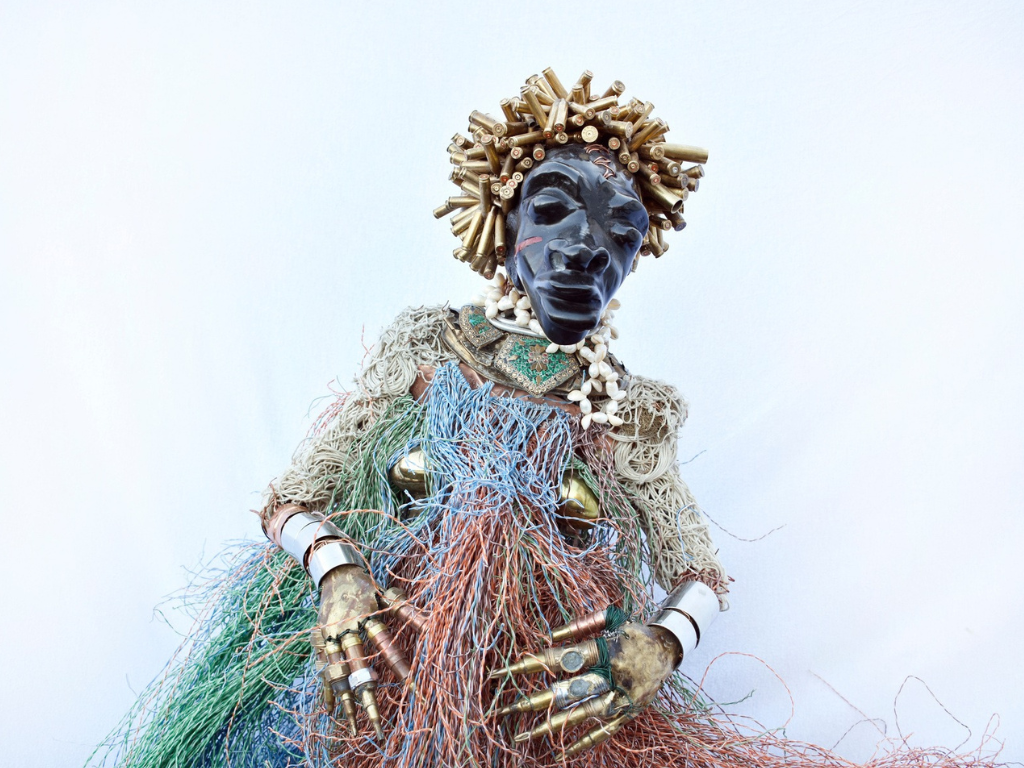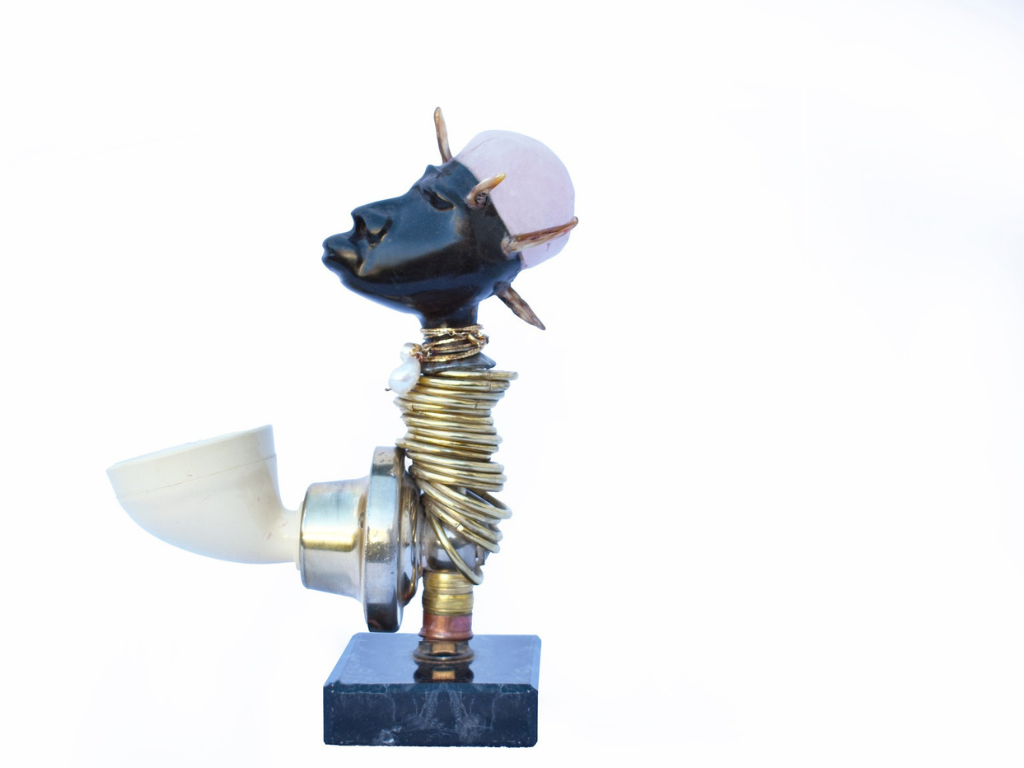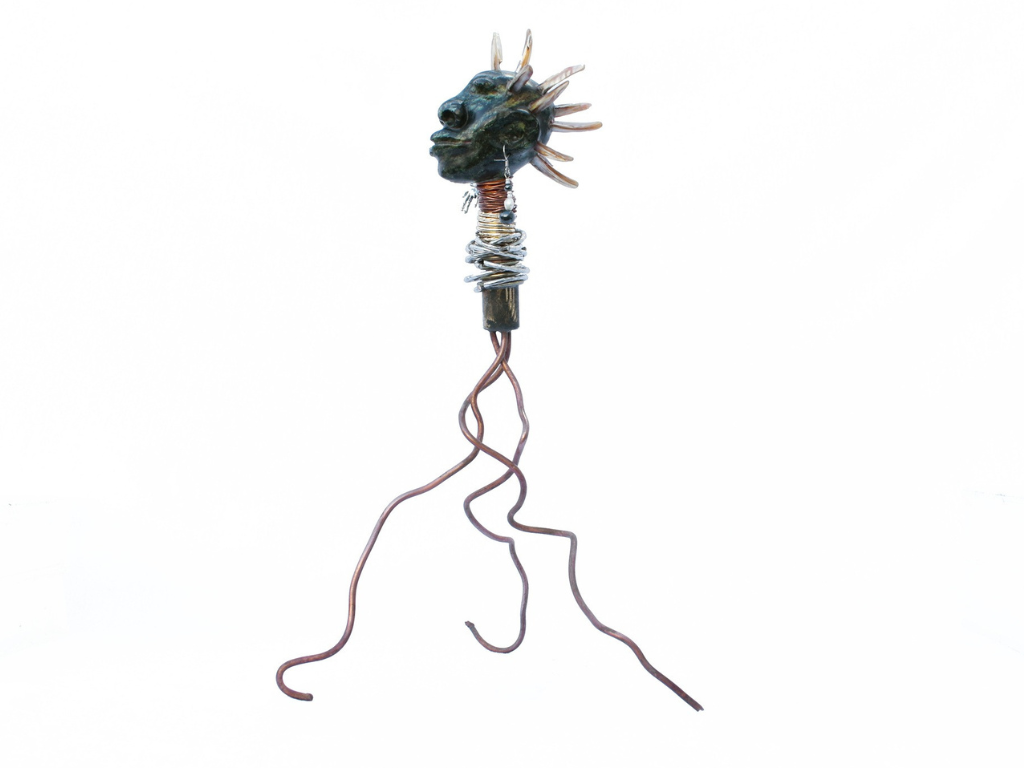Enigma of Origin
Terrence Musekiwa

Terrence Musekiwa
Enigma of Origin
Installation view
The bodies of the sculptures range from full figures to totemic forms and hybrid beings, each constructed from recycled materials—copper pipes, bicycle parts, artillery shells, brass plates, internet cabling, and Victorian curtain rings. Through layering, twisting, and interweaving these elements, his figures manifest as hybrid entities, drawing connections between indigenous customs and remnants of global militarization.

Terrence Musekiwa
Enigma of Origin
Installation view

Terrence Musekiwa
Chifamba nezvanza, 2024
Springstone, red jasper, brass bullet casings,
brass curtain rings, aluminium, steel, and iron,
45 × 120 × 100 cm

Terrence Musekiwa
Chifamba nezvanza, 2024
Detail

Terrence Musekiwa
Enigma of Origin
Installation view
Presented atop glass-brick plinths, Musekiwa’s works nod to the architectural heritage of post-independence African nations, where glass bricks, influenced by Modernist and Brutalist ideals, came to symbolize resilience and modernity. Soviet and Eastern European architectural collaborators helped shape educational and government buildings in Zimbabwe, incorporating Brutalist designs that expressed stability and progress. In this context, the glass bricks bridge architecture and sculpture, cluing the viewer into the works historical continuity.

Terrence Musekiwa,
Mutongwizo, 2024
Detail

Terrence Musekiwa,
Mutongwizo, 2024
Springstone, Butter Jade, copper
pearls, brass bullet casings,
brass, aluminum,
And internet cables
89 × 72 × 44 cm

Terrence Musekiwa
Enigma of Origin
Installation view
Musekiwa carves heads from a myriad of rare stones specific to mines in Zimbabwe. Most prominent is Springstone, a rich black stone which Musekiwa connects to the ancestral spirits of another realm. He inlays the blackness with red jasper and pastel-green butter jade, recalling scarification practices. Adornments of cowrie shells, pearls, plastic broom fibers, and brass bullet casings sourced from the Salisbury Plain Training Area in the UK—an expansive military site where global powers conduct training. This choice echoes Zimbabwe’s own history, where Harare, once named Salisbury under Rhodesian occupation, symbolized a landscape caught between indigenous heritage and imposed foreign influence, a dynamic Musekiwa engages in each work to underscore connections to the socio-political moment.

Terrence Musekiwa
Ambuya (Ella), 2024
Springstone, Butter Jade, glass,
pearls, synthetic pearls,
brass, and aluminum
96 × 33 × 35 cm


Terrence Musekiwa,
nyakukuvadzwa, 2024
Springstone, brass bullet casings,
brass artillery shell, brass and
aluminium,
61 × 19 × 19 cm

Terrence Musekiwa,
nyakukuvadzwa, 2024
Detail

Terrence Musekiwa,
Svovanepasi, 2024,
Springstone, red jasper, curtain rings,
brass bullet casings, glass, crystal,
copper, aluminium, steel, and iron,
28 × 98, x 37 cm (`dimensions variable)

Terrence Musekiwa
Mubvakachi (visitor), 2024
Springstone, butter jade, copper, brass,
aluminium, crystal, glass, and malachite
21 × 10 × 13.5 cm

Terrence Musekiwa
Mubvakachi (visitor), 2024
Detail

Terrence Musekiwa
Muni (visitor), 2024
Lepidolite, silver plated forks, brass,
copper and aluminium
28 × 29 × 26 cm

Terrence Musekiwa
Mupitikiri, 2024
Springstone, rose quartz, pearls,
1940’s telephone receiver, marble,
brass, copper and aluminium
19.5 × 14 × 6.5 cm

Terrence Musekiwa
Werudzi (one of us), 2024
Serpentine, 1930’s telephone
receiver, marble, and aluminium,
28 × 13 × 10 cm

Terrence Musekiwa,
Rooted, 2024
Cobalt stone, pearls,
copper and aluminium,
52 × 27 × 34 cm

Terrence Musekiwa
Murwi (warrior), 2024
Springstone, Butter Jade, Red Jasper,
cowrie shells, pearls, synthetic fibers,
brass, and aluminum
73 × 35 × 23

Terrence Musekiwa
Muera nungu, 2024
Spring`stone, 1930’s `brass artillery `shell,
brass bullet casings, copper and aluminium
37 × 13 × 7 cM

Terrence Musekiwa
Muera nungu 2 (Sikarudzi), 2024
Leopard stone, pearls, abalone shell,
copper, aluminium and brass,
36 × 21 × 24 cm

Terrence Musekiwa
Chawazi, 2024
Springstone, quartz, pearls, 1960’s
telephone receiver, marble, and brass,
22 × 12 × 12 cm

Terrence Musekiwa
Mumwe werudzi, 2024
Springstone, pearls, 1960’s telephone
receiver, marble, and brass,
22 × 11 × 9 cm
Enigma of Origin
Solo Presentation by Terrence Musekiwa
Positions | Booth P15
Catinca Tabacaru Gallery for Art Basel Miami 2024
Catinca Tabacaru Gallery proudly presents Enigma of Origin, a solo exhibition by Zimbabwean artist Terrence Musekiwa. Known for his intricate stone and found-object sculptures, Musekiwa merges traditional stone-carving techniques with contemporary sculptural practices, building upon the layered narratives embedded in everyday objects and historical artifacts.
Rooted in Chikaranga heritage, Musekiwa’s practice reflects a nuanced, syncretic exploration of the ecological, historical, and socio-political contexts of the African continent. Viewed through this lens, Musekiwa engages in a global dialogue that reveals the interconnected nature of resistance struggles, where histories of oppression and acts of defiance are woven together across temporal and geographic boundaries. Each movement for autonomy or justice resonates beyond its immediate context, linking one to another as part of a shared pursuit of liberation and resilience.
Musekiwa carves heads from a myriad of rare stones specific to mines in Zimbabwe. Most prominent is Springstone, a rich black stone which Musekiwa connects to the ancestral spirits of another realm. He inlays the blackness with red jasper and pastel-green butter jade, recalling scarification practices. Adornments of cowrie shells, pearls, plastic broom fibers, and brass bullet casings sourced from the Salisbury Plain Training Area in the UK—an expansive military site where global powers conduct training – are added to accentuate the works’ connection to the socio-political moment.
The bodies of the sculptures range from full figures to totemic forms and hybrid beings, each constructed from recycled materials—copper pipes, bicycle parts, artillery shells, brass plates, internet cabling, and Victorian rings. Through layering, twisting, and interweaving these elements, his figures manifest as hybrid entities, drawing connections between indigenous customs and remnants of global militarization.
Presented atop glass-brick plinths, Musekiwa’s works nod to the architectural heritage of post-independence African nations, where glass bricks, influenced by Modernist and Brutalist ideals, came to symbolize resilience and modernity. Soviet and Eastern European architectural collaborators helped shape educational and government buildings in Zimbabwe, incorporating Brutalist designs that expressed stability and progress. In this context, the glass bricks bridge architecture and sculpture, cluing the viewer into the works historical continuity.
This spiritual realm, as channeled by Musekiwa, mirrors humanity itself: a fusion of divine and earthly influences, where cultural resilience meets legacies of governance and occupations by a foreign nations and indirect forms of domination that have created contemporary realities, yet to be fully understood. Musekiwa offers a meditation on the human experience, reminding us that our connection to the divine is woven into the fabric of our everyday lives.